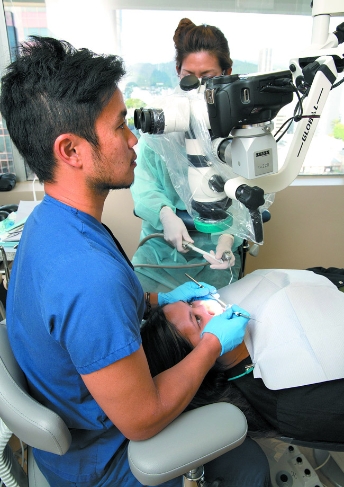Hi-tech Root Canal Therapy
Dr. Noz Yamauchi
Board certified endodontist and president/owner of Island Endodontics
Where did you receiving your schooling and training?
I went to dental school at the University of North Carolina and then went on to complete my residency with a combined master’s program that took three years, also at the University of North Carolina.
mw-dih-drnozyamauchi-2
A year later, I completed and received my board certification by the American Board of Endodontics. Board certification is the highest level of certification in the specialty, and there are only a few here in Hawaii.
How long have you been in practice?
I have been practicing in Hawaii for three years.
What is an endodontist?
An endodontist is a dentist who has completed specialty training in endodontics, which deals with the treatment of root canals. Any dentist can perform root canals, but an endodontist has had additional training in the field.
When does a person need a root canal?
Typically, when bacteria and other microorganisms enter the root canal spaces inside the root of a tooth, it can lead to inflammation and infection. This can result in a great deal of discomfort. Sometimes there is no pain, but an abscess may have formed in the bone under the root of a tooth.
What are the symptoms that indicate there is a problem tooth?
There may be pain to temperature, cold and hot, that is very sensitive and may linger, and there may be spontaneous pain that aches and radiates throughout the face. Sometimes there is no discomfort, but findings of infection, such as an abscess, around the roots of teeth on a radiograph.
What happens during a root canal?
The main goal is to eliminate the bacteria and other microorganisms that infect the root canals and surrounding bone of the teeth. Typically the tooth is anesthetized or numbed, and the canal spaces where the bacteria have caused disease are carefully cleaned. This may be done in one visit, but may take a few appointments based on the extent of the infection. We create a small access through the top of the tooth and clean out the canals. If the infection in the bone does not heal after the root canal, then we also can access the infection through the side with minor gum surgery, typically called endodontic surgery or apicoectomy.
You mentioned new technology that you use to help with the procedure and put the patient at ease. Can you describe the latest technological advancements?
One of the most important things we use is a dental operating microscope. This allows us to see things at much higher magnification so that we can work more precisely when performing root canal therapy. We have digital cameras attached to our microscope and take pictures of all our treatments so that we can show our patients and referring dentists what exactly we are doing. I believe showing our patients through X-rays and clinical pictures allows them to understand and appreciate the care we are providing.
We use the microscope from start to finish, and this is very important to be able to provide the highest quality care. Our assistants also are trained to use a microscope that is attached to the doctor’s so that they can work as a team to provide the best treatment.
We also have a dental CT imaging machine called a CBCT. This allows us to visualize the structures in 3-D rather than the conventional 2-D X-rays. This has significantly improved our ability to diagnose and treat our patients.
Anything else you’d like to add?
Most people have this idea that root canals are very painful and scary. We actually get people out of pain and treat their infection. Once we have given local anesthesia, “numbing,” you shouldn’t feel anything during the treatment. And afterward, most patients don’t need to take any pain medication.
What are some preventative measures a person can practice to avoid needing a root canal?
The best thing to prevent needing a root canal is to avoid allowing a cavity to form and get deep inside the tooth. Getting normal checkups, brushing, flossing and using fluoride rinses are all things that can help.
Can you talk about your volunteer work that helps the underserved?
I volunteer, providing free dental care at Aloha Medical Mission for the underserved. I think it’s important to give back to the community and this is a great way to do that. I also teach endodontics for residents at the Kokua Kalihi Valley dental health care clinic.






